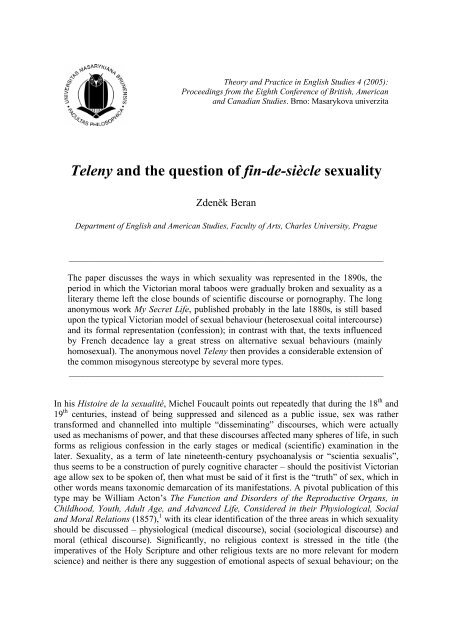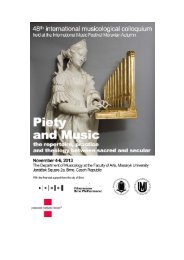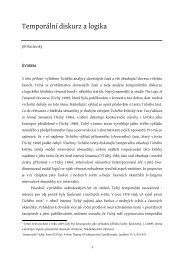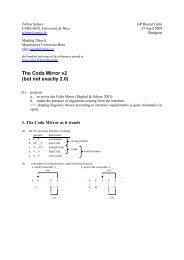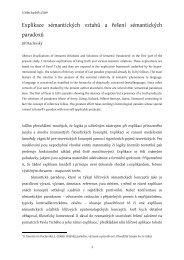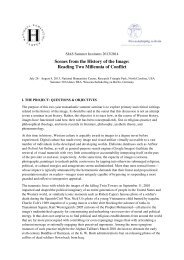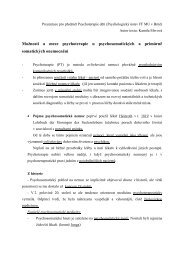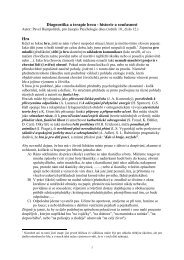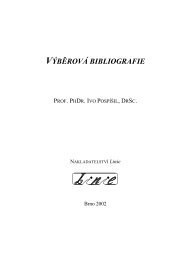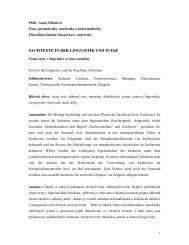Teleny and the question of fin-de-siècle sexuality - Masarykova ...
Teleny and the question of fin-de-siècle sexuality - Masarykova ...
Teleny and the question of fin-de-siècle sexuality - Masarykova ...
You also want an ePaper? Increase the reach of your titles
YUMPU automatically turns print PDFs into web optimized ePapers that Google loves.
Theory <strong>and</strong> Practice in English Studies 4 (2005):<br />
Proceedings from <strong>the</strong> Eighth Conference <strong>of</strong> British, American<br />
<strong>and</strong> Canadian Studies. Brno: <strong>Masarykova</strong> univerzita<br />
<strong>Teleny</strong> <strong>and</strong> <strong>the</strong> <strong>question</strong> <strong>of</strong> <strong>fin</strong>-<strong>de</strong>-<strong>siècle</strong> <strong>sexuality</strong><br />
Z<strong>de</strong>nk Beran<br />
Department <strong>of</strong> English <strong>and</strong> American Studies, Faculty <strong>of</strong> Arts, Charles University, Prague<br />
_____________________________________________________________________<br />
The paper discusses <strong>the</strong> ways in which <strong>sexuality</strong> was represented in <strong>the</strong> 1890s, <strong>the</strong><br />
period in which <strong>the</strong> Victorian moral taboos were gradually broken <strong>and</strong> <strong>sexuality</strong> as a<br />
literary <strong>the</strong>me left <strong>the</strong> close bounds <strong>of</strong> scientific discourse or pornography. The long<br />
anonymous work My Secret Life, published probably in <strong>the</strong> late 1880s, is still based<br />
upon <strong>the</strong> typical Victorian mo<strong>de</strong>l <strong>of</strong> sexual behaviour (heterosexual coital intercourse)<br />
<strong>and</strong> its formal representation (confession); in contrast with that, <strong>the</strong> texts influenced<br />
by French <strong>de</strong>ca<strong>de</strong>nce lay a great stress on alternative sexual behaviours (mainly<br />
homosexual). The anonymous novel <strong>Teleny</strong> <strong>the</strong>n provi<strong>de</strong>s a consi<strong>de</strong>rable extension <strong>of</strong><br />
<strong>the</strong> common misogynous stereotype by several more types.<br />
_____________________________________________________________________<br />
In his Histoire <strong>de</strong> la sexualité, Michel Foucault points out repeatedly that during <strong>the</strong> 18 th <strong>and</strong><br />
19 th centuries, instead <strong>of</strong> being suppressed <strong>and</strong> silenced as a public issue, sex was ra<strong>the</strong>r<br />
transformed <strong>and</strong> channelled into multiple “disseminating” discourses, which were actually<br />
used as mechanisms <strong>of</strong> power, <strong>and</strong> that <strong>the</strong>se discourses affected many spheres <strong>of</strong> life, in such<br />
forms as religious confession in <strong>the</strong> early stages or medical (scientific) examination in <strong>the</strong><br />
later. Sexuality, as a term <strong>of</strong> late nineteenth-century psychoanalysis or “scientia sexualis”,<br />
thus seems to be a construction <strong>of</strong> purely cognitive character – should <strong>the</strong> positivist Victorian<br />
age allow sex to be spoken <strong>of</strong>, <strong>the</strong>n what must be said <strong>of</strong> it first is <strong>the</strong> “truth” <strong>of</strong> sex, which in<br />
o<strong>the</strong>r words means taxonomic <strong>de</strong>marcation <strong>of</strong> its manifestations. A pivotal publication <strong>of</strong> this<br />
type may be William Acton’s The Function <strong>and</strong> Disor<strong>de</strong>rs <strong>of</strong> <strong>the</strong> Reproductive Organs, in<br />
Childhood, Youth, Adult Age, <strong>and</strong> Advanced Life, Consi<strong>de</strong>red in <strong>the</strong>ir Physiological, Social<br />
<strong>and</strong> Moral Relations (1857), 1 with its clear i<strong>de</strong>ntification <strong>of</strong> <strong>the</strong> three areas in which <strong>sexuality</strong><br />
should be discussed – physiological (medical discourse), social (sociological discourse) <strong>and</strong><br />
moral (ethical discourse). Significantly, no religious context is stressed in <strong>the</strong> title (<strong>the</strong><br />
imperatives <strong>of</strong> <strong>the</strong> Holy Scripture <strong>and</strong> o<strong>the</strong>r religious texts are no more relevant for mo<strong>de</strong>rn<br />
science) <strong>and</strong> nei<strong>the</strong>r is <strong>the</strong>re any suggestion <strong>of</strong> emotional aspects <strong>of</strong> sexual behaviour; on <strong>the</strong>
Z<strong>de</strong>nk Beran<br />
o<strong>the</strong>r h<strong>and</strong>, what is <strong>of</strong>fered instead <strong>of</strong> <strong>the</strong> sphere <strong>of</strong> <strong>de</strong>light, is <strong>the</strong> Malthusian <strong>question</strong> <strong>of</strong><br />
reproduction (<strong>and</strong> population) – a crucial <strong>question</strong> in<strong>de</strong>ed for <strong>the</strong> Victorian world.<br />
In fiction, or at least in <strong>of</strong>ficially published fiction, any direct representation <strong>of</strong> sex<br />
was <strong>of</strong> course taboo before 1890. Had a novel broken this rule, it would have faced <strong>the</strong> danger<br />
<strong>of</strong> being exclu<strong>de</strong>d from Mudie’s Select Library, <strong>the</strong> most prestigious <strong>and</strong> influential<br />
circulating library <strong>of</strong> <strong>the</strong> times, <strong>and</strong> this would drastically have diminished <strong>the</strong> book’s market<br />
potential. Now it is not <strong>the</strong> aim <strong>of</strong> this paper to show how sex was portrayed indirectly in <strong>the</strong><br />
Victorian novel nor is it my intention to discuss un<strong>of</strong>ficial publications <strong>and</strong> <strong>the</strong>ir practices in<br />
this matter. I would like to mention just one title that may be taken as presenting a pre-<strong>fin</strong>-<strong>de</strong><strong>siècle</strong><br />
mo<strong>de</strong>l <strong>of</strong> 19 th -century <strong>sexuality</strong>: it is an anonymous book called My Secret Life, <strong>and</strong><br />
though its eleven volumes were in<strong>de</strong>ed not issued by any <strong>of</strong>ficial London publishing house,<br />
<strong>the</strong>re seems to be a good reason for its inclusion. Foucault mentions <strong>the</strong> book as an almost<br />
single example <strong>of</strong> a Victorian text <strong>de</strong>aling openly with <strong>sexuality</strong> <strong>and</strong> it was also given a<br />
prominent place in <strong>the</strong> seminal <strong>the</strong>oretical treatment <strong>of</strong> <strong>the</strong> topic – Pr<strong>of</strong>essor Steven Marcus’<br />
The O<strong>the</strong>r Victorians – where two full chapters (more than 120 pages) are <strong>de</strong>voted to <strong>the</strong><br />
discussion <strong>of</strong> this single publication. Moreover, it is perhaps <strong>the</strong> only Victorian book <strong>of</strong> this<br />
character that received any real critical attention <strong>and</strong> whose republication in <strong>the</strong> 20 th century<br />
was motivated by scholarly interests mostly. There are <strong>of</strong> course many uncertainties<br />
concerning this unconventional work: we do not know who <strong>the</strong> author was, <strong>the</strong> only i<strong>de</strong>ntity<br />
given being his (assumed) first name Walter; we cannot say when exactly <strong>the</strong> 4200-odd pages<br />
<strong>of</strong> his only literary production were written; <strong>and</strong> it is not even clear when <strong>the</strong> individual<br />
volumes were published for <strong>the</strong> first time. Some sources give <strong>the</strong> year <strong>of</strong> publication as 1888<br />
(cf Marcus 1969: 78-83) but this date can only be accepted very tentatively. The title page <strong>of</strong><br />
each volume bears no o<strong>the</strong>r imprint than that i<strong>de</strong>ntifying <strong>the</strong> place <strong>of</strong> publication as<br />
Amsterdam. What is known for sure is <strong>the</strong> fact that <strong>the</strong> number <strong>of</strong> copies was very limited;<br />
traditionally it was believed <strong>the</strong>re were just six, though now it seems <strong>the</strong>re were slightly more,<br />
perhaps twenty five. Never<strong>the</strong>less, My Secret Life was a very limited edition, though not an<br />
exquisite one – it was printed ra<strong>the</strong>r poorly <strong>and</strong> was full <strong>of</strong> various printing errors.<br />
My Secret Life is a <strong>de</strong>tailed account <strong>of</strong> <strong>the</strong> author’s sexual feats during many years <strong>of</strong><br />
his life, a life systematically oriented towards a single activity – sex. It is however not true<br />
that <strong>the</strong> book “<strong>de</strong>scribes every known form <strong>of</strong> sexual perversion, from lesbianism, pe<strong>de</strong>rasty<br />
<strong>and</strong> flagellomania to sodomy, incest <strong>and</strong> bestiality” (Marcus 1969: 78), as one <strong>of</strong> <strong>the</strong> early<br />
commentators, Ralph Ginzburg, claimed, without evi<strong>de</strong>ntly having read <strong>the</strong> book. No won<strong>de</strong>r<br />
Marcus calls Ginzburg’s Unhurried View <strong>of</strong> Erotica a work <strong>of</strong> immaculate ignorance. Its<br />
author seems to be quite unreflectively influenced by <strong>the</strong> vocabulary <strong>of</strong> those Victorian <strong>and</strong><br />
post-Victorian critics who turned away in awe from <strong>the</strong> “naughty-nineties” writers, for whom<br />
“perversion” was a focal point in <strong>the</strong>ir treatment <strong>of</strong> human sexual life. This was, however, by<br />
no means “Walter’s” case. Even though during those long years <strong>of</strong> uninhibited sexual life he<br />
in<strong>de</strong>ed experimented with various forms <strong>of</strong> sexual behaviour, <strong>the</strong> central <strong>and</strong> prevailing form<br />
was always that <strong>of</strong> heterogenic coital sex. And although any kind <strong>of</strong> emotional involvement<br />
was ra<strong>the</strong>r exceptional with him, we cannot even say that he took women simply as sexual<br />
objects.<br />
Drs. Eberhard <strong>and</strong> Phyllis Kronhausen, American sexologists <strong>and</strong> editors <strong>of</strong> a twovolume<br />
selection from My Secret Life (1967), comment upon “Walter’s” relationship to<br />
women in <strong>the</strong> way that is actually very polemical with Marcus’ own critical attitu<strong>de</strong> to<br />
“Walter’s” <strong>de</strong>eds:<br />
“We shall see […] how remarkably positive Walter, by <strong>and</strong> large, felt towards women,<br />
how little hostility he ever showed <strong>the</strong>m, <strong>and</strong> <strong>of</strong> how much enthusiasm he was capable<br />
regarding even those aspects <strong>of</strong> feminine sex anatomy which are generally <strong>the</strong> least<br />
28
<strong>Teleny</strong> <strong>and</strong> <strong>the</strong> <strong>question</strong> <strong>of</strong> <strong>fin</strong>-<strong>de</strong>-<strong>siècle</strong> <strong>sexuality</strong><br />
appreciated. More precisely, he was able to see as much beauty <strong>and</strong> poetry in a<br />
woman’s sex organs as o<strong>the</strong>rs may see in a work <strong>of</strong> art. For that alone he <strong>de</strong>serves, we<br />
feel, consi<strong>de</strong>rable credit in a world so <strong>of</strong>ten tainted by misogyny <strong>and</strong> disparagement <strong>of</strong><br />
what men have been pleased to call <strong>the</strong> weaker sex.” (Eberhard <strong>and</strong> Kronhausen 1967:<br />
xv)<br />
Accepting <strong>the</strong>se appreciative words, we may conclu<strong>de</strong> that “Walter” is in many respects in<br />
accord with Victorian i<strong>de</strong>as <strong>of</strong> <strong>sexuality</strong>, ra<strong>the</strong>r than <strong>the</strong> o<strong>the</strong>r way around. Of course, he<br />
differs in <strong>the</strong> essential formal <strong>de</strong>m<strong>and</strong>s – his sex is nei<strong>the</strong>r marital nor temperate; on <strong>the</strong><br />
contrary, it is blatantly extramarital, or promiscuous, in mo<strong>de</strong>rn terms, <strong>and</strong> it is blatantly<br />
excessive. Compared to Acton’s advice <strong>of</strong> sexual temperance, if not abstinence, even in<br />
married life, “Walter” in<strong>de</strong>ed seems to be a rebel against <strong>the</strong> Victorian sexual co<strong>de</strong>. But <strong>the</strong>re<br />
are o<strong>the</strong>r aspects <strong>of</strong> his sexual behaviour that seem to confirm what may be called <strong>the</strong><br />
mainstream mo<strong>de</strong>l <strong>of</strong> Victorian sexual behaviour: <strong>the</strong> heterosexual coital intercourse may<br />
symbolically st<strong>and</strong> for <strong>the</strong> productive purpose <strong>of</strong> <strong>sexuality</strong>. “Walter’s” attitu<strong>de</strong> towards his<br />
sexual partners bears clear marks <strong>of</strong> <strong>the</strong> acts <strong>of</strong> altruism (he not only presented <strong>the</strong>m with<br />
some money, but also used to buy small gifts for <strong>the</strong>m, which might be helpful especially for<br />
<strong>the</strong> working-class girls), <strong>and</strong> he took <strong>the</strong>se acquaintances as real sexual partners, always<br />
careful to please <strong>the</strong>m too, or at least to enrich <strong>the</strong>ir own sexual experience. But above all, his<br />
presentation <strong>of</strong> his rich sexual experience completes <strong>the</strong> typical Victorian discourse <strong>of</strong> sex: his<br />
account is much more a clinical record <strong>of</strong> sexual behaviour than a pornographic fantasia;<br />
“Walter” is very careful not to distort <strong>the</strong> truth <strong>and</strong> to present each event with a matter-<strong>of</strong>-fact<br />
approach <strong>of</strong> a scientist. This is also why his work is so appreciated in our times – he recor<strong>de</strong>d<br />
his experiences shortly after <strong>the</strong>ir consummation in or<strong>de</strong>r to give all <strong>de</strong>tails with as great<br />
precision <strong>and</strong> au<strong>the</strong>nticity as possible. And in<strong>de</strong>ed, we discover that he consistently uses some<br />
terminology, though <strong>of</strong> course a subst<strong>and</strong>ard one, <strong>and</strong> <strong>the</strong>refore his text has a consi<strong>de</strong>rable<br />
socio-linguistic merit too (pego, quim, etc.). Thus he can be viewed not only as one <strong>of</strong> <strong>the</strong><br />
most uninhibited Victorian libertines but also as one <strong>of</strong> <strong>the</strong> typical Victorian amateurscientists,<br />
although his field was ra<strong>the</strong>r <strong>de</strong>licate.<br />
What distinguishes <strong>the</strong> <strong>fin</strong>-<strong>de</strong>-<strong>siècle</strong> conceptions <strong>of</strong> <strong>sexuality</strong> from <strong>the</strong> preceding ones<br />
is exactly <strong>the</strong> difference with which <strong>the</strong> relationship between man <strong>and</strong> woman were<br />
un<strong>de</strong>rstood. Late Victorian male aes<strong>the</strong>tes <strong>and</strong> <strong>de</strong>ca<strong>de</strong>nts <strong>de</strong>rived <strong>the</strong>ir i<strong>de</strong>as <strong>of</strong> femininity<br />
from more or less misogynous discourses that had been going on through nearly <strong>the</strong> whole<br />
nineteenth century. Arthur Schopenhauer provi<strong>de</strong>d some important clues by showing how<br />
substantially different <strong>the</strong> two sexes are: woman is only a half-child for him, a middle stage<br />
between a child <strong>and</strong> a man; woman is an incarnation <strong>of</strong> all that is temporary (due to her<br />
quickly passing beauty, which is <strong>the</strong> only true feminine quality), whereas man embodies<br />
permanence; woman is a creature <strong>of</strong> a limited or “short-sighted” mind, whereas man is<br />
endowed with much broa<strong>de</strong>r intelligence; woman is a natural hypocrite <strong>and</strong> liar; woman’s<br />
i<strong>de</strong>ntity is that <strong>of</strong> a species ra<strong>the</strong>r than <strong>of</strong> an individual, because her only task <strong>and</strong> goal is to<br />
maintain <strong>the</strong> continuance <strong>of</strong> <strong>the</strong> human race; <strong>and</strong> on top <strong>of</strong> that all, women are ugly <strong>and</strong><br />
tasteless <strong>and</strong> only <strong>the</strong> man’s mind blin<strong>de</strong>d by <strong>the</strong> sexual drive can call <strong>the</strong>se creatures <strong>of</strong> small<br />
stature, narrow back, wi<strong>de</strong> hips <strong>and</strong> short legs beautiful. This insufficiency also perhaps<br />
explains why women do not un<strong>de</strong>rst<strong>and</strong> art <strong>and</strong> are not able to create real, original, great<br />
works <strong>of</strong> art, <strong>the</strong> German philosopher maintains. Schopenhauer’s controversial i<strong>de</strong>as were<br />
later adopted by Bau<strong>de</strong>laire, who was fascinated by <strong>the</strong> images <strong>of</strong> prostitutes <strong>and</strong> actresses,<br />
women representing Evil, <strong>de</strong>cay, <strong>de</strong>ath, matter <strong>and</strong> all that is natural in contrast to <strong>the</strong><br />
masculine domain <strong>of</strong> <strong>the</strong> spiritual, artistic, artificial, <strong>and</strong> eternal. Female <strong>sexuality</strong> is<br />
essentially dangerous for man because it is predatory, vampiric <strong>and</strong> <strong>de</strong>structive, it is matter<br />
29
Z<strong>de</strong>nk Beran<br />
<strong>de</strong>vouring <strong>the</strong> spirit. Like in <strong>the</strong> pictures <strong>of</strong> Felicien Rops, it is a skeleton <strong>of</strong> rotting flesh <strong>and</strong><br />
bleached bones hid<strong>de</strong>n behind a beautiful mask.<br />
Elaine Showalter, in her discussion <strong>of</strong> <strong>the</strong> character <strong>of</strong> <strong>fin</strong>-<strong>de</strong>-<strong>siècle</strong> <strong>sexuality</strong>, uses<br />
Sigmund Freud’s interpretation <strong>of</strong> <strong>the</strong> myth <strong>of</strong> Medusa’s head to elucidate what female<br />
<strong>sexuality</strong> meant for <strong>the</strong> effeminate aes<strong>the</strong>tic men <strong>of</strong> <strong>the</strong> end <strong>of</strong> <strong>the</strong> century. For <strong>the</strong>m to unveil<br />
<strong>the</strong> Medusa, whose unshiel<strong>de</strong>d gaze turns men into stone, is to confront <strong>the</strong> dread <strong>of</strong> looking<br />
at <strong>the</strong> female sexual organs (for <strong>the</strong> head in <strong>the</strong> Freudian semantic transposition st<strong>and</strong>s for “an<br />
upward displacement <strong>of</strong> sexual organs”); what lies behind <strong>the</strong> veil is actually <strong>the</strong> spectre <strong>of</strong><br />
female <strong>sexuality</strong>, a silent but terrible mouth that may wound or even <strong>de</strong>vour <strong>the</strong> male<br />
spectator. This can be interpreted as a reflection <strong>of</strong> <strong>the</strong> strict nineteenth-century moral<br />
doctrine, by which <strong>the</strong> female genitalia were a strict taboo for <strong>the</strong> inquisitive male gaze. But<br />
<strong>the</strong>re may be more behind this image <strong>of</strong> <strong>the</strong> strange ne<strong>the</strong>r mouth, <strong>of</strong> <strong>the</strong> “vagina <strong>de</strong>ntata”, as<br />
it is called. The fact is that female <strong>sexuality</strong> was really envisioned as a dangerous, sharp<br />
weapon. Showalter provi<strong>de</strong>s a quotation from Edmond <strong>de</strong> Goncourt’s 1883 journal, in which<br />
<strong>the</strong> novelist noted down his dream about an actress at a party dancing stark naked on a table,<br />
<strong>and</strong> “while she was dancing took steps that showed her private parts armed with <strong>the</strong> most<br />
terrible jaws one could imagine, opening <strong>and</strong> closing, exposing a set <strong>of</strong> teeth” (Showalter<br />
1991: 148). Yet even earlier examples <strong>of</strong> somewhat similar character can be found in French<br />
literature <strong>of</strong> <strong>the</strong> period. In his poem “Une Négresse par le <strong>de</strong>mon secouée” (A Negress<br />
Possessed by a Demon, 1864) Stéphane Mallarmé lets an old black woman expose her<br />
genitalia before a frightened young girl’s eyes <strong>and</strong> during this act her “strange mouth” is<br />
preparing to turn <strong>the</strong> girl into a victim, to swallow her figuratively, which may mean to make<br />
a prostitute out <strong>of</strong> her, <strong>the</strong> same as <strong>the</strong> old Negress is – to arm her too with a vagina <strong>de</strong>ntata.<br />
The most famous tale <strong>of</strong> Les Diaboliques by Jules Barbey d’Aurevilly, “The Feast <strong>of</strong> <strong>the</strong><br />
A<strong>the</strong>ists”, is conclu<strong>de</strong>d by a horrible scene in which a <strong>de</strong>ceived husb<strong>and</strong> seals his wife’s<br />
vagina with hot wax <strong>and</strong> thus “silences” her, shuts her mouth, for ever.<br />
Roger Caillois (1938) connects <strong>the</strong> frequent i<strong>de</strong>ntification <strong>of</strong> <strong>the</strong> mouth <strong>and</strong> vagina, or<br />
better <strong>the</strong> <strong>de</strong>light <strong>of</strong> eating <strong>and</strong> <strong>the</strong> <strong>de</strong>light <strong>of</strong> sexual intercourse, with <strong>the</strong> castration complex –<br />
this may in<strong>de</strong>ed be a strong part <strong>of</strong> man’s psychology in <strong>the</strong> <strong>fin</strong> <strong>de</strong> <strong>siècle</strong>. Parallels between<br />
sexual <strong>and</strong> alimentary attributes are conspicuously frequent in <strong>fin</strong>-<strong>de</strong>-<strong>siècle</strong> texts, especially<br />
ones between semen <strong>and</strong> milk, i.e. ejaculation <strong>and</strong> breastfeeding. In Dracula <strong>and</strong> o<strong>the</strong>r<br />
vampiric fiction, semen is paralleled with blood, which <strong>the</strong> sucking vampire feeds on, <strong>and</strong> <strong>the</strong><br />
result is i<strong>de</strong>ntical – contagion: a vampire’s victim becomes himself a vampire, one <strong>of</strong> <strong>the</strong><br />
un<strong>de</strong>ad; a prostitute’s client becomes syphilitic, one <strong>of</strong> <strong>the</strong> living <strong>de</strong>ad. But it is also important<br />
that Caillois discusses <strong>the</strong> problem <strong>of</strong> mouth/vagina i<strong>de</strong>ntification as part <strong>of</strong> his treatise on <strong>the</strong><br />
praying mantis, where he analyses <strong>the</strong> insect’s famous behaviour during copulation, when <strong>the</strong><br />
female starts eating <strong>the</strong> male by <strong>de</strong>capitating him. This may st<strong>and</strong> as a sexual emblem for<br />
many cultures (as is reflected in <strong>the</strong>ir myths <strong>and</strong> legends), but for <strong>fin</strong>-<strong>de</strong>-<strong>siècle</strong> sex discourse it<br />
provi<strong>de</strong>s special poignancy: heterosexual intercourse is <strong>de</strong>structive, <strong>the</strong> source <strong>of</strong> <strong>de</strong>struction<br />
comes from <strong>the</strong> female part, <strong>and</strong> this <strong>de</strong>structiveness is natural because it is validated by<br />
nature (<strong>the</strong>re are also o<strong>the</strong>r insects that behave similarly); from <strong>the</strong> male’s point <strong>of</strong> view, it is<br />
<strong>the</strong>refore highly advisable to avoid it <strong>and</strong> to con<strong>de</strong>mn it. The most obvious substitution <strong>the</strong>n,<br />
for <strong>fin</strong>-<strong>de</strong>-<strong>siècle</strong> man, is its direct anti<strong>the</strong>sis, homo<strong>sexuality</strong>. Through it he not only avoids<br />
nature in her raw impulses, but also his own inabilities: for if <strong>the</strong> mantis male is <strong>de</strong>stroyed in<br />
<strong>the</strong> very process <strong>of</strong> reproduction, he is in fact replaced by his progeny <strong>and</strong> his wilful selfeffacement<br />
can be interpreted as sacrifice, as a ritualised <strong>de</strong>ath on behalf <strong>of</strong> new life, whereas<br />
what <strong>the</strong> enfeebled, effeminate <strong>de</strong>ca<strong>de</strong>nt man fears is complete <strong>de</strong>struction as a form <strong>of</strong><br />
punishment for his insufficient physicality, sensuality, <strong>and</strong> virility.<br />
The focal text <strong>of</strong> this misogynous vagina <strong>de</strong>ntata mo<strong>de</strong>l in English literature is Oscar<br />
Wil<strong>de</strong>’s Salomé, where homosexual relationships make up one <strong>of</strong> <strong>the</strong> subsidiary motives. Yet<br />
30
<strong>Teleny</strong> <strong>and</strong> <strong>the</strong> <strong>question</strong> <strong>of</strong> <strong>fin</strong>-<strong>de</strong>-<strong>siècle</strong> <strong>sexuality</strong><br />
<strong>the</strong> book in which homo<strong>sexuality</strong> was presented without any restraints in<strong>de</strong>ed is a <strong>fin</strong>-<strong>de</strong><strong>siècle</strong><br />
novel called <strong>Teleny</strong>, a story <strong>of</strong> passionate love between an oversensitive young man<br />
Camille Des Grieux <strong>and</strong> a Hungarian pianist <strong>of</strong> remarkable talent René <strong>Teleny</strong>. The aim <strong>of</strong> <strong>the</strong><br />
following paragraphs, however, is not to <strong>de</strong>al with <strong>the</strong> novel’s homosexual apparatus, but to<br />
suggest to what extent <strong>and</strong> how it revises <strong>the</strong> familiar misogynous mo<strong>de</strong>l – in o<strong>the</strong>r words, to<br />
see how female <strong>sexuality</strong> is represented in a text based fully on a male homosexual discourse.<br />
Before doing this, it is worthwhile summarising <strong>the</strong> remarkable history <strong>of</strong> <strong>the</strong> book, both in its<br />
manuscript <strong>and</strong> printed form.<br />
The first appearance <strong>of</strong> <strong>the</strong> title dates back to <strong>the</strong> last weeks <strong>of</strong> <strong>the</strong> year 1890, when<br />
Oscar Wil<strong>de</strong> brought a wrapped parcel into a recently opened London bookshop Libraire<br />
Parisienne <strong>and</strong> asked its owner, Charles Hirsch, to give it to a young man who would come to<br />
claim it. In this way <strong>the</strong> manuscript <strong>of</strong> <strong>Teleny</strong> – because this was exactly what <strong>the</strong> parcel<br />
contained – was subsequently borrowed <strong>and</strong> returned by three young men before Hirsch read<br />
it himself. Hirsch, who also secretly <strong>de</strong>alt in pornography, came to <strong>the</strong> conclusion that this<br />
interesting story must have been written by Wil<strong>de</strong>’s intimate friends <strong>and</strong> that Oscar Wil<strong>de</strong> had<br />
corrected <strong>and</strong> revised it <strong>and</strong> contributed some <strong>fin</strong>er parts himself. This view has not much<br />
altered since. Shortly after Hirsch’s acquaintance with <strong>the</strong> text, Wil<strong>de</strong> took <strong>the</strong> manuscript<br />
away <strong>and</strong> next time <strong>the</strong> title appeared was three years later when <strong>the</strong> book was published by<br />
Leonard Smi<strong>the</strong>rs as <strong>Teleny</strong>, or The Reverse <strong>of</strong> <strong>the</strong> Medal: A Psychological Romance. Hirsch<br />
noticed some important changes in <strong>the</strong> text, <strong>the</strong> most conspicuous being <strong>the</strong> shift <strong>of</strong> scene<br />
from London to Paris. After Smi<strong>the</strong>r’s <strong>de</strong>ath in 1909 Hirsch managed to get <strong>the</strong> original<br />
manuscript <strong>of</strong> <strong>the</strong> novel <strong>and</strong> in 1934 <strong>Teleny</strong> came out privately in French translation with<br />
Hirsch’s introduction giving <strong>the</strong> above account <strong>of</strong> its history. Unfortunately, <strong>the</strong> manuscript<br />
was lost, so what we have today are two printed versions <strong>of</strong> <strong>the</strong> book – an English one with<br />
Smi<strong>the</strong>rs’ (<strong>and</strong> perhaps not only his) changes <strong>and</strong> additions <strong>and</strong> a French one being a<br />
rendition <strong>of</strong> <strong>the</strong> original manuscript. A Gay Sunshine Press edition <strong>of</strong> <strong>Teleny</strong>, published in<br />
1984, is a carefully collated compromise prepared by Winston Leyl<strong>and</strong>.<br />
The novel is a complex work, unlike cheap pornographic writings: its construction is<br />
very skilful <strong>and</strong> consistent, <strong>the</strong>re is a genuine attempt to view <strong>the</strong> problem <strong>of</strong> male <strong>sexuality</strong><br />
with some psychological insight <strong>and</strong> <strong>the</strong> text retains a unifying elegiac note. Moreover, <strong>the</strong>re<br />
are passages showing <strong>the</strong> author’s intimate interest in arts <strong>and</strong> music, <strong>and</strong> <strong>the</strong>se were probably<br />
written by Wil<strong>de</strong> himself. The opening chapter – if we lay asi<strong>de</strong> <strong>the</strong> formal introductory part<br />
conceived conventionally as a repenting confession <strong>of</strong> <strong>the</strong> dying Des Grieux – provi<strong>de</strong>s <strong>the</strong><br />
rea<strong>de</strong>r with an important clue regarding <strong>the</strong> feminine world. Des Grieux meets <strong>Teleny</strong> for <strong>the</strong><br />
first time at a charity concert given by his mo<strong>the</strong>r <strong>and</strong> <strong>the</strong> encounter is almost magical: an<br />
intense, though unconscious, transfer <strong>of</strong> sexual powers takes place between <strong>the</strong> two young<br />
men, a transfer resulting in <strong>Teleny</strong>’s unprece<strong>de</strong>ntedly superb musical performance <strong>and</strong> in Des<br />
Grieux’s extraordinarily lush imagination instigated by <strong>the</strong> music. The scene has an obvious<br />
Schopenhauerian un<strong>de</strong>rtone – sexual <strong>de</strong>sire projected into music as a form <strong>of</strong> art brings about<br />
such intensity <strong>of</strong> experience which woman, a “sexus sequior”, is not capable <strong>of</strong>. This clearly<br />
postulates <strong>the</strong> character <strong>of</strong> discourse which places <strong>Teleny</strong> firmly in <strong>the</strong> <strong>fin</strong>-<strong>de</strong>-<strong>siècle</strong> context.<br />
Though <strong>the</strong> novel openly presents scenes <strong>of</strong> sexual activities between men, it by no<br />
means shirks a direct <strong>de</strong>piction <strong>of</strong> female <strong>sexuality</strong>, but it is easy to see that <strong>the</strong> presentation<br />
<strong>of</strong> women has a specific function <strong>of</strong> creating certain types <strong>of</strong> frustration in man’s mind. There<br />
are three major occasions when Des Grieux meets with female <strong>sexuality</strong> <strong>and</strong> <strong>the</strong>se moments<br />
in a way make up three different types <strong>of</strong> frustration. The first one is his early visit to a Soho<br />
bro<strong>the</strong>l with some <strong>of</strong> his friends. Here he watches ugly prostitutes displaying different sexual<br />
activities to <strong>the</strong>ir guests <strong>and</strong> <strong>the</strong> experience turns into a disgusting spectacle, a danse macabre<br />
<strong>of</strong> fleshliness, a wild carnival <strong>of</strong> rotting bodies, culminating in <strong>the</strong> <strong>de</strong>ath <strong>of</strong> a consumptive<br />
ghostly girl during her attempt to please an old, fat cantinière. Femininity in this scene is<br />
31
Z<strong>de</strong>nk Beran<br />
reduced to mere animality, carnality <strong>and</strong> morbidity; bodily pleasures are indistinguishable<br />
from <strong>de</strong>ath, as <strong>the</strong> girl dies at <strong>the</strong> moment <strong>of</strong> <strong>the</strong> old woman’s orgasm: “Thus it happened that<br />
<strong>the</strong> <strong>de</strong>ath-rattle <strong>of</strong> <strong>the</strong> one mixed itself up with <strong>the</strong> panting <strong>and</strong> gurgling <strong>of</strong> <strong>the</strong> o<strong>the</strong>r.” 2 This is<br />
an extreme Bau<strong>de</strong>lairean or even Zolaesque picture, or ra<strong>the</strong>r a caricature <strong>of</strong> it, <strong>and</strong> in<strong>de</strong>ed <strong>the</strong><br />
rea<strong>de</strong>r might have heard in it a Zolaesque echo <strong>of</strong> French naturalism, which met with such a<br />
controversial reception in Engl<strong>and</strong> in <strong>the</strong> 1880s.<br />
The second occasion comes at <strong>the</strong> moment Des Grieux is disappointed by <strong>Teleny</strong>’s<br />
permanent flirtation with his admirers <strong>and</strong> tries to forget <strong>the</strong> pianist. This is <strong>the</strong> time a new<br />
maid named Ca<strong>the</strong>rine is employed by his mo<strong>the</strong>r <strong>and</strong> Des Grieux exploits <strong>the</strong> situation to<br />
have sex with her. However much she likes him, she is not willing to give up her virginity so<br />
easily <strong>and</strong> Des Grieux’s attempts resemble a violent, yet inefficient conquest: <strong>the</strong> two fight<br />
like wild cats, <strong>and</strong> although Des Grieux wins <strong>fin</strong>ally, he is not able to penetrate her.<br />
Ca<strong>the</strong>rine’s virginity seems unconquerable for him, it is an “insurmountable obstacle”, a<br />
“stronghold”, a “blind alley”, 3 <strong>and</strong> after his vain attempts <strong>the</strong> young man “exhausted by [his]<br />
nightly rambles, [falls] almost senseless by her si<strong>de</strong>”. Yet <strong>the</strong>re is ano<strong>the</strong>r man around, a<br />
coachman <strong>of</strong> <strong>the</strong> family, who falls in love with <strong>the</strong> girl, <strong>and</strong> being disdained by her, he<br />
stealthily hi<strong>de</strong>s in her bedroom to enjoy her when she goes to bed. This he eventually does,<br />
but, as <strong>the</strong> text says, it “was hardly a <strong>question</strong> with him now <strong>of</strong> pleasure given or received, it<br />
was <strong>the</strong> wild overpowering eagerness which <strong>the</strong> male brute displays in possessing <strong>the</strong> female,<br />
for you might have killed him, but he would not have left go his hold. He thrust at her with all<br />
<strong>the</strong> mighty heaviness <strong>of</strong> a bull” (90). 4 At first it would seem that <strong>the</strong>re is ano<strong>the</strong>r echo <strong>of</strong><br />
Zolaism in this <strong>de</strong>scription – in love-making, man is reduced to a brutal force, to a strong<br />
beast acting blindly, driven by mere instincts. This brutality is in<strong>de</strong>ed not a victory, because<br />
<strong>the</strong> poor raped girl kills herself by plunging out <strong>of</strong> <strong>the</strong> open window immediately after <strong>the</strong> act.<br />
For Des Grieux, however, <strong>the</strong> experience remains ambiguous – hetero<strong>sexuality</strong> has presented<br />
itself as something unattainable unless <strong>the</strong> re<strong>fin</strong>ed, “aes<strong>the</strong>ticised” man changes into a violent<br />
<strong>and</strong> ru<strong>de</strong> beast; if not, woman remains an impenetrable, unvanquishable obstacle. Not a<br />
vagina <strong>de</strong>ntata, but a vagina obstructa.<br />
The last scene in which <strong>the</strong> <strong>fin</strong>-<strong>de</strong>-<strong>siècle</strong> man’s perception <strong>of</strong> feminine <strong>sexuality</strong> is<br />
represented comes almost at <strong>the</strong> end <strong>of</strong> <strong>the</strong> novel. <strong>Teleny</strong> <strong>and</strong> Des Grieux have to part for<br />
several days, during which <strong>the</strong> pianist will give concerts in Brighton, but in <strong>the</strong> evening after<br />
his leaving Des Grieux, with great surprise, discovers dim light in his rooms. His surprise is<br />
all <strong>the</strong> greater when he peers through <strong>the</strong> keyhole into <strong>Teleny</strong>’s bedroom <strong>and</strong> sees his friend<br />
having sex with a beautiful naked woman. Des Grieux’s voyeurism analogises that <strong>of</strong> <strong>the</strong><br />
rea<strong>de</strong>r – his covert gaze turns <strong>the</strong> woman into an objet d’art, it objectifies her <strong>and</strong> in this way<br />
<strong>de</strong>sires <strong>and</strong> appropriates her like any connoisseur <strong>of</strong> beauty <strong>and</strong> artistic perfection. How<br />
immense his shock is, however, when he <strong>fin</strong>ds out that <strong>the</strong> beautiful woman is his own still<br />
young mo<strong>the</strong>r. <strong>Teleny</strong> tries to explain his treacherous behaviour as a form <strong>of</strong> gratitu<strong>de</strong> for Des<br />
Grieux’s mo<strong>the</strong>r’s paying his huge <strong>de</strong>bts, but Des Grieux (who has in fact paid <strong>the</strong> friend’s<br />
<strong>de</strong>bts himself) does not listen. Instead, he <strong>de</strong>ci<strong>de</strong>s to commit suici<strong>de</strong>, <strong>and</strong> when he recovers<br />
from his unsuccessful attempt, he <strong>fin</strong>ds <strong>Teleny</strong> himself dying in a pool <strong>of</strong> blood. The third<br />
appearance <strong>of</strong> female <strong>sexuality</strong> is even more <strong>de</strong>structive than <strong>the</strong> preceding two <strong>and</strong> <strong>fin</strong>-<strong>de</strong><strong>siècle</strong><br />
man <strong>fin</strong>ds a new frustration in it – that <strong>of</strong> incest. The fear <strong>of</strong> <strong>the</strong> Oedipus complex is not<br />
only suggested by Des Grieux’s possessive voyeurism, but also by <strong>the</strong> fact that, like in many<br />
homosexual texts, Camille Des Grieux <strong>and</strong> René <strong>Teleny</strong> are conceived as doubles, as an i<strong>de</strong>al<br />
complementary unity <strong>of</strong> <strong>the</strong> male body <strong>and</strong> mind. Moreover, this late, climactic scene closely<br />
corresponds with one <strong>of</strong> <strong>the</strong> early episo<strong>de</strong>s when Des Grieux, soon after meeting <strong>Teleny</strong> <strong>and</strong><br />
still uncertain about his feelings towards him, has a very intense wet dream in which he<br />
copulates with his own sister, a sister he has never had, <strong>and</strong> at <strong>the</strong> moment <strong>of</strong> orgasm is<br />
woken up by his mo<strong>the</strong>r. Incestuous hetero<strong>sexuality</strong>, as presented in <strong>the</strong> book, is thus based<br />
32
<strong>Teleny</strong> <strong>and</strong> <strong>the</strong> <strong>question</strong> <strong>of</strong> <strong>fin</strong>-<strong>de</strong>-<strong>siècle</strong> <strong>sexuality</strong><br />
on a ra<strong>the</strong>r complex i<strong>de</strong>ntification pattern (Des Grieux-<strong>Teleny</strong>, <strong>Teleny</strong>-Des Grieux’s sister,<br />
sister-mo<strong>the</strong>r).<br />
To conclu<strong>de</strong>: <strong>the</strong> anonymous novel <strong>Teleny</strong>, be it a work <strong>of</strong> Oscar Wil<strong>de</strong> or not, not<br />
only establishes itself as a typical <strong>fin</strong>-<strong>de</strong>-<strong>siècle</strong> text, but also consi<strong>de</strong>rably broa<strong>de</strong>ns <strong>the</strong> scope<br />
<strong>of</strong> female <strong>sexuality</strong> as presented in homosexual male discourse <strong>of</strong> <strong>the</strong> end <strong>of</strong> <strong>the</strong> 19 th century.<br />
The French déca<strong>de</strong>nce image <strong>of</strong> vagina <strong>de</strong>ntata, representing <strong>the</strong> castration complex, is<br />
importantly matched by three more frustrating images – a Zolaesque image <strong>of</strong> woman as<br />
repulsive, yet untameable flesh, an impenetrable vagina image representing <strong>the</strong> impotence<br />
complex <strong>and</strong> a mo<strong>the</strong>r-as-sexual-object image representing <strong>the</strong> incest complex. <strong>Teleny</strong> may<br />
exemplify <strong>the</strong> Foucauldian i<strong>de</strong>a <strong>of</strong> discourse as confession – this time it is an unexpectedly<br />
open <strong>and</strong> unexpectedly rich one.<br />
Endnotes:<br />
1<br />
This work is broadly discussed in Steven Marcus’ The O<strong>the</strong>r Victorians: A Study <strong>of</strong><br />
Sexuality <strong>and</strong> Pornography in Mid-Nineteenth Century Engl<strong>and</strong>, London: Corgi Books,<br />
1969: 12-33.<br />
2<br />
<strong>Teleny</strong>, a novel attributed to Oscar Wil<strong>de</strong>, San Francisco: Gay Sunshine Press, 1984: 61.<br />
3<br />
Des Grieux’s comments are <strong>of</strong>ten metaphorical: “Just as when driving a nail in a wall, <strong>the</strong><br />
point meets a stone, <strong>and</strong> hammering away, <strong>the</strong> tip gets blunt, <strong>the</strong>n turns on itself, so as I<br />
pressed har<strong>de</strong>r, <strong>the</strong> point <strong>of</strong> my tool was crushed <strong>and</strong> strangled.” <strong>Teleny</strong>: 85.<br />
4<br />
<strong>Teleny</strong>: 90.<br />
Works Cited<br />
Caillois, Roger (1938) Le My<strong>the</strong> et l’homme, Paris: Gallimard.<br />
Foucault, Michel (1978) The History <strong>of</strong> Sexuality, vol. 1: An Introduction, trans. by Robert<br />
Hurley, New York: Pan<strong>the</strong>on.<br />
Kronhausen, Eberhard <strong>and</strong> Phyllis, Drs (1967) Walter, <strong>the</strong> English Casanova: a presentation<br />
<strong>of</strong> his unique memoirs ‘My Secret Life’, London: Polybooks Ltd.<br />
Leyl<strong>and</strong>, Winston (ed) (1984) <strong>Teleny</strong>, a novel attributed to Oscar Wil<strong>de</strong>, San Francisco: Gay<br />
Sunshine Press.<br />
Marcus, Steven (1969) The O<strong>the</strong>r Victorians: A Study <strong>of</strong> Sexuality <strong>and</strong> Pornography in Mid-<br />
Nineteenth Century Engl<strong>and</strong>, London: Corgi Books.<br />
Showalter, Elaine (1991) Sexual Anarchy. Gen<strong>de</strong>r <strong>and</strong> Culture at <strong>the</strong> Fin <strong>de</strong> Siècle, London:<br />
Bloomsbury.<br />
33


